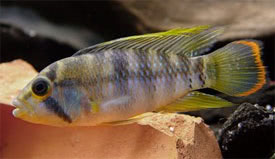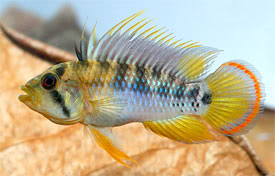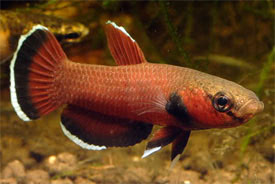
 Magyarul / Hungarian
Magyarul / Hungarian




- Scientific name: Apistogramma baenschi
- Synonyms: -
- Common name: Inca cichlid
- Group: Cichlids
- Habitat: South America; Peru
- Size: male: 5,5 cm, female 4 cm
- Biotope: Inhabits in the tributary of the Rio Shanushi and in the lower Rio Huallaga in central Peru, but the full distribution is still unknown. Usually found in shallow, blackwater forest streams.
- Social behavior: Peaceful, but during spawning they become territorial and aggressive. Wild caught specimens should be kept alone, or with small, peaceful characins.
- Diet: Carnivorous, wild caught fish only accept live foods, but once settled they eat frozen or flake foods too. They may eat small snails too.
- Breeding: Quite easy
- Tank: Minimum 50 litres
- Population: 1 male and 2-3 female for 75 litres.
- Decoration: Needs a tank with dense vegetation and cave-like hiding places among rocks and roots. Or simulate their natural habitat with lots of roots and branches, and a substrate of sand with leaf litter on it. Weekly, small (10-15%) water changes are essential.
- Temperature: 24-28 °C
- pH: 4-6.5
- Hardness: 1-5 NK°
- Lifespan: 3-5 years
Description: Apistogramma baenschi was discovered in 2002 by a German scientist who guided a group of Japanese hobbyists in Peru. These hobbyists introduced the fish in Japan where they get immediate attention from the global dwarf cichlid community. Several expeditions were launched to the area and in 2003 the species was commercially available in the hobby. In 2004 the fish was finally described as Apistogramma baenschi in honour of Romer’s publisher friend Hans A. Baensch. Inca cichlid can be distinguished from all other species of Apistogramma by the 5 complete, intense vertical bars on its sides and a small blotch at the base of the caudal fin. Males have a blue body with red marginated caudal fin. Females are yellowish-grey in color and have a black spot at the base of the pectorals which becomes prominent when they are brood caring. A black band runs from the eye to the bottom of the gill cover.
Males are larger, more colourful and develop more extended fins than females. Breeding is not too difficult, with soft, slightly acid water. Shelter breeders, the female will lay its pink colored eggs usually on the roof of a cave or in cavities among rocks. After spawning the the female takes care of the eggs. The eggs hatch after 48-72 hours and the female moves the larval fry to a pit in the substrate. The male should be removed, as the female may become aggressive. After another 4-5 days the young fish become free-swimming, and the female will lead them out to begin feeding. They can be fed with baby brine shrimp or with other small live foods. Juveniles become sexually mature at about 4 months.










